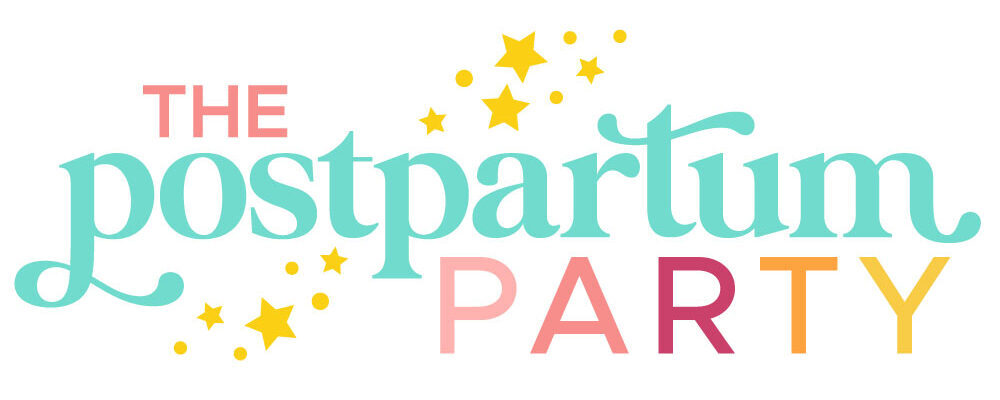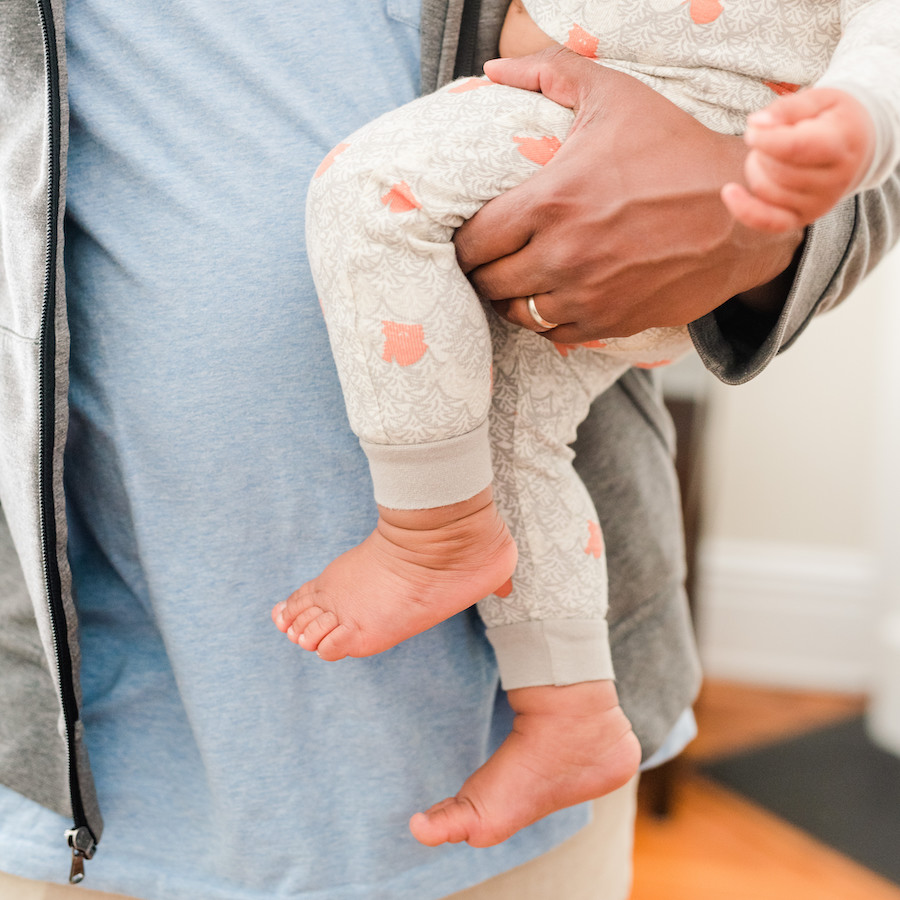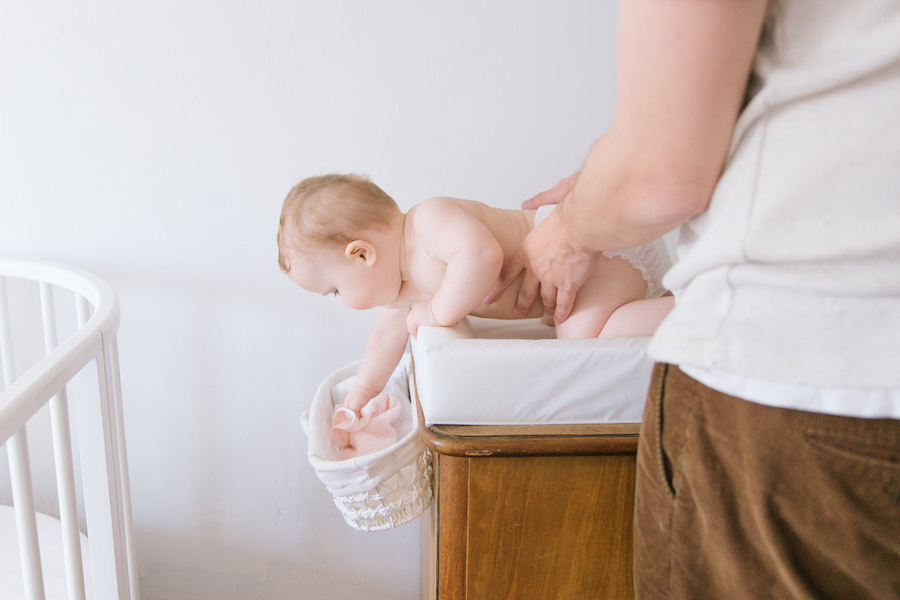The Soothing Ladder is a series of steps parents can take to help get your newborn to sleep, before rushing to feed or rock baby to sleep. See how to use the soothing ladder with your baby.
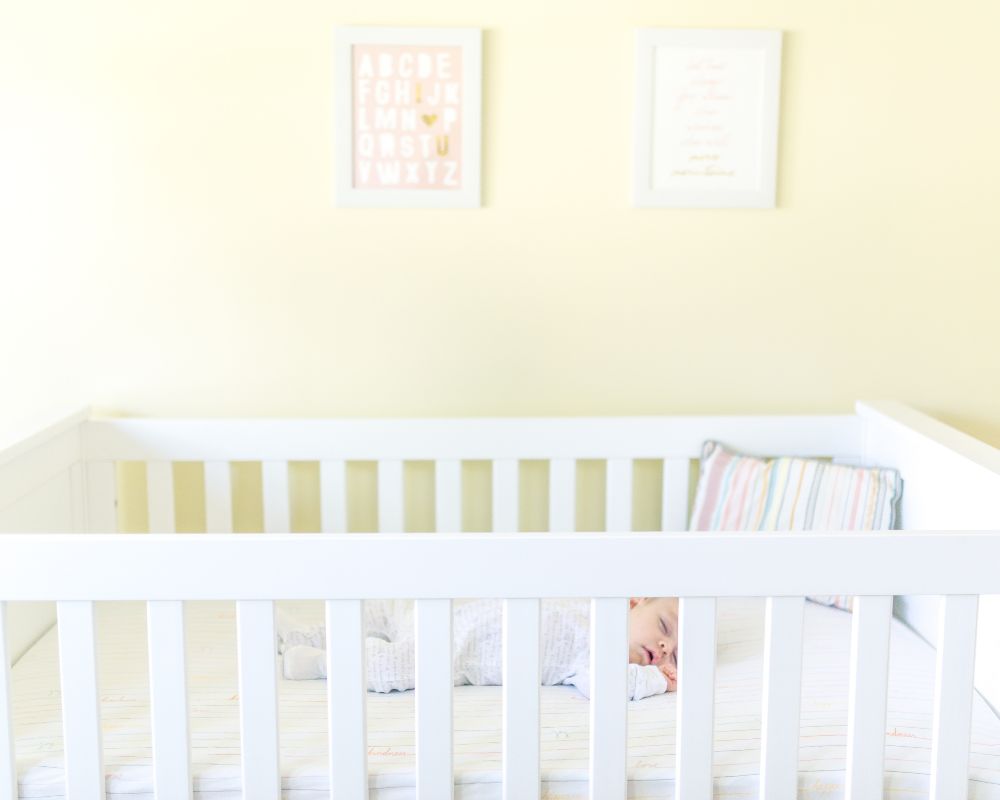
As a new mom, I read so many parenting books on sleep and all of them said the same things:
- Avoid an overtired baby
- Follow eat/play/sleep
- Focus on full feedings
- Put baby down awake
I remember reading one particular book several times thinking I had missed something.
None of them shared how:
How to get my baby to fall asleep in the bassinet or crib?
And then,
What do I do if baby fights sleep?
Then I learned about The Soothing Ladder and how to use it to help my newborn fall asleep in her crib or bassinet.
Since then, I’ve used it with families I’ve worked with to help them get their newborns to sleep as well.
If you’ve ever wondered how people get their baby to fall asleep in the crib or bassinet, then let me introduce you to the Soothing Ladder and how it can help your newborn baby sleep in their own sleep space.
What Age is the Soothing Ladder For?
The Soothing Ladder, from The Happy Sleeper. works best for newborns–5 months old.
Does the Soothing Ladder Work?
Yes, the Soothing Ladder can be a very effective way to help your baby fall asleep in their crib or bassinet.
It provides parents with a set of interventions that you can move through to help your baby learn to self-soothe and fall asleep without being attached to the breast or bottle.
By becoming attuned to your baby’s naturally progressing self-soothing techniques, you’ll start to understand when your baby does (and doesn’t!) need your help getting to sleep.
The idea is that you’ll respond to your baby’s needs in the moment, sometimes with more or less parental involvement.
And eventually, as your baby’s self-soothing improves, you’ll spend less and less time on the higher (more involved) ladder steps.
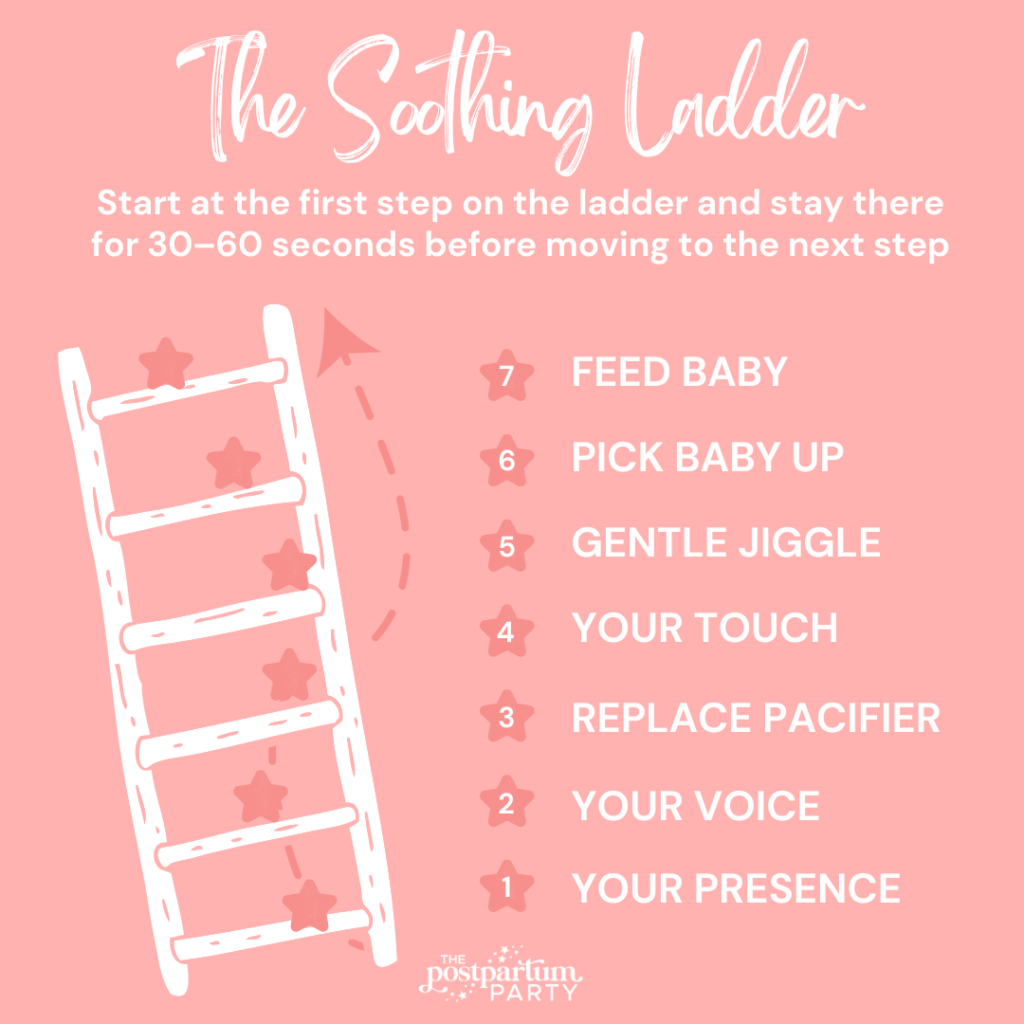
How To Do the Soothing Ladder
In the Soothing Ladder, parents follow a series of steps to comfort your baby.
You start at the bottom step, which is the least amount of parental involvement, and gradually go up each step as your baby needs it.
You can choose how much time to give your baby on each step, but try to stay consistent. Start with about 30-60 seconds on each step, and see how that feels.
When babies are very young, it might be more like 15-30 seconds.
Each step requires more and more parent involvement the higher you go up the ladder.
You may need to keep climbing the steps, or your baby may settle when you are on step 3 or 4.
Every baby is different and you’ll soon learn the steps that work best for your baby.
For example, early in the process your baby might need assistance up to step 5 or 6. But as they get better at self-soothing, you might only get to the first rung or two.
You’ll continue to go up the steps as needed, until your baby is calm in their crib or bassinet.
Once you leave the room, if your baby wakes up or starts crying again, you’ll come back and start at the first step again.
What Are the Steps on the Soothing Ladder?
These are an example of steps in a soothing ladder.
As you learn your baby, you can replace some of the steps and create your own soothing ladder to help soothe your baby.
Remember to start with the first one and stay there for about 30–60 seconds. If baby settles down, you might be done.
If your baby still needs you, move onto the next step of the soothing ladder and continue to climb the ladder (do each step) until your baby calms down or falls asleep.
Your Presence
Sometimes just being in the same room as your baby can be comforting to them.
If your baby is having a hard time falling asleep, or wakes up in the middle of the night, try going into their room and standing near her crib to see if that helps calm them.
Don’t touch them or use your voice just yet, just show them that you’re there. Wait 30-60 seconds before moving onto the next step of the soothing ladder (only if baby is still crying).
Your Voice
Your voice can be also be soothing to your baby. Try making a shushing sound, or you can speak softly, hum, or sing.
Do this for the same amount of time you spent on the first rung, and only move on if baby is still upset.
Replace the Pacifier
Did your baby’s pacifier fall out or is out of their reach? They may just need you to pop it back in. You could even try holding the pacifier in their mouth for a few seconds if they need help settling.
If your baby doesn’t use a pacifier, you can skip to the next rung.
Your Touch
If your baby still needs some help, it’s time to physically give them some comfort.
You can place a gentle, firm hand on your baby’s chest. You could also pat them gently on their chest or belly.
Some babies enjoy their heads being gently rubbed. Don’t pick them up just yet, and wait another 30-60 seconds to see if your touch soothes them.
Jiggle
A gentle jiggle motion sometimes reminds babies of the womb. You can do this with your hand on your baby’s back, or jiggle the bassinet/crib mattress. Some bassinets even have this feature built in!
Pick up your Baby
If none of the previous steps have worked, go ahead and pick up your baby and hold or rock them until they’ve stopped crying.
You can then set them back down once they’re calm and start back at the bottom step if needed.
Feed your Baby
If all else fails and you move through every other rung of the ladder with no moments of calm, your little one might need a feeding.
Do your best not to let them doze off while they feed. Set them back down with a full tummy before starting back at the first rung.
Video on the Soothing Ladder
Watch the video below to learn about how to do the steps of the soothing ladder to help your baby sleep. Sometimes it helps to hear someone explain it versus reading a blog post.
When Can I Start Using the Soothing Ladder?
You can use the Soothing Ladder even from their earliest newborn days.
I always recommend taking a curious approach to your baby.
This means being fully present and engaged in helping soothe your baby, while also taking moments to take a slight step back and watch for self-soothing abilities.
The Soothing Ladder is a great tool to help your baby fall asleep in their crib or bassinet.
It can also be a great tool if you feel like your baby hates the crib.
By the time your baby reaches 4 months old, you will have learned to read your baby’s cues well. Your attuned responses to their needs will create a secure attachment between you.
As long as your baby has started to show some signs of being able to self-soothe around the 4 month mark, you can begin to work the Soothing Ladder method into your sleep training method.
However, keep in mind that all babies develop at their own pace. Just because your baby is 4 months old, it doesn’t mean that they (or you!) are ready to sleep train.
Take your time to really assess that you’re both ready to sleep train before you go all in, because remaining consistent is key to sleep training success.
What is the Shush Pat Method?
The soothing ladder uses two methods of soothing that were popularized by Tracy Hogg, author of The Baby Whisperer: shushing and patting.
The Shush Pat method is one of my favorites to use when helping fussy newborns get to sleep. It involves patting your baby’s back rhythmically while shushing in their ear, all while they lay in their crib.
Even though you’re providing some soothing assistance, the Shush Pat method allows your baby to fall asleep in the same environment that they’ll be waking up in.
When they wake up in the middle of the night, their environment will be the same and it’s typically easier for them to fall back asleep.
If your baby is younger than four months old, the Shush Pat Method is a super effective way to help them fall asleep. Not only can it help a baby extend naps that are too short, it can help with soothing during nighttime wakings.
When Should Babies Learn to Self Soothe?
As soon as they are born into this world, babies begin learning. Babies can learn to self soothe at a pretty young age if given the chance.
The authors of the Happy Sleeper and myself emphasize taking a curious approach because it allows parents to pause before jumping right in to do the soothing for our babies. The more practice we give our babies to self soothe, the better.
Newborn babies are capable of falling asleep on their own, especially if they have a full tummy and aren’t overtired.
But if your little one needs some soothing help while they’re learning, that is totally okay.
Using the Soothing Ladder is a great option to provide a little assistance.
Get Your Newborn to Sleep
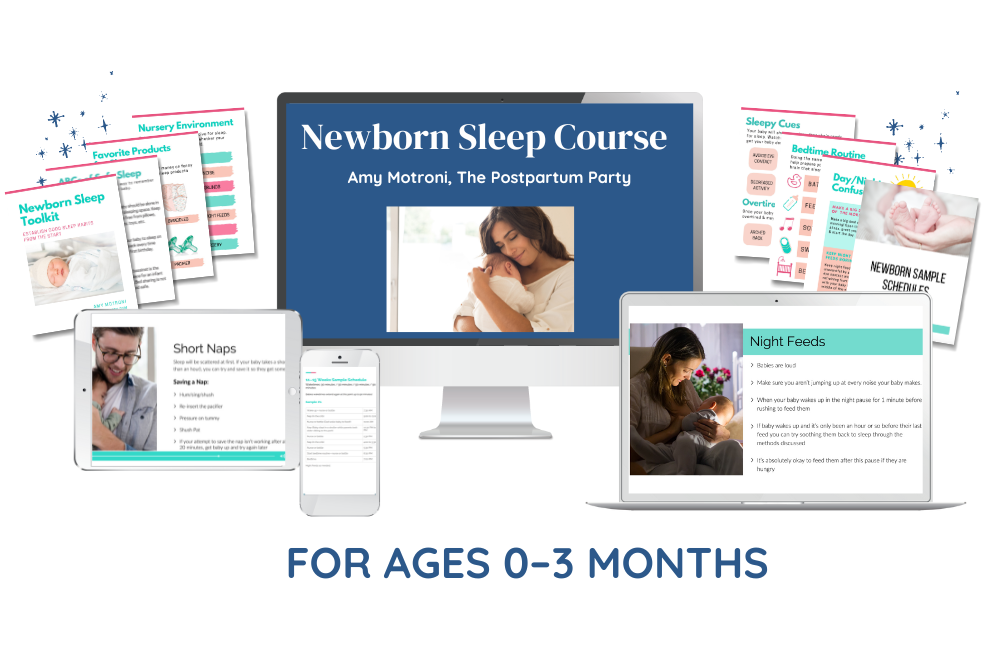
Learn how to get your newborn to fall asleep and stay asleep with the Newborn Sleep Course. You’ll learn expert sleep tips for soothing your baby to sleep, establishing easy routines, and how to start reducing night feeds when your newborn is ready. Learn more here.
- Practical Tips if your Toddler is Going Through A 3-Year Old Sleep Regression - April 26, 2024
- Baby Led Weaning vs Purees — Which Should I Choose? - April 25, 2024
- 10 Adorable Letter Board Pregnancy Announcements - April 25, 2024
